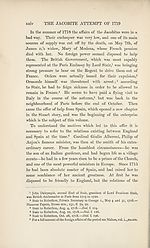Series 1 > Jacobite attempt of 1719
(42) Page xxv
Download files
Complete book:
Individual page:
Thumbnail gallery: Grid view | List view

INTRODUCTION
XXV
two countries had become more and more hostile, and in the
summer of 1718 they had reached a critical condition. In
1717 war broke out between Spain and the Emperor Charles vi.
The first scene of operations was Sardinia, which was occupied
by a Spanish force. Early in 1718 a great armament was fitted
out at Barcelona. Its obvious destination was either Italy or
Sicily. England was bound by the Treaty of Utrecht to
guarantee the neutrality of Italy, and by that of Westminster,
concluded with the Emperor in May 1716, to maintain the
integrity of the imperial dominions, of which Naples formed a
part. Diplomatic remonstrance was fruitless, and things rapidly
drifted towards hostilities. Before Parliament rose in March,
the House of Commons, in answer to a royal message, under¬
took to make good any necessary excess of expenditure on the
sea service for the year. On the 4th of June Sir George
Byng sailed from Spithead with twenty ships of the line.
Byng’s orders were precise. On reaching the Mediterranean
he was to intimate his arrival to the King of Spain, and to
state that he was instructed to use all means to promote peace.
If, however, the Spaniards persisted in attacking imperial
territory in Italy, or occupying Sicily, ‘ in such case,’ the orders
ran, ‘ you are, with all your power, to hinder and obstruct the
same.’1
On the 30th of June, N.s., Byng reached Cape St. Vincent,
and sent his secretary with a letter to Colonel Stanhope, the
British envoy at Madrid, detailing his orders. Stanhope
showed the letter to Alberoni, who, on reading it, absolutely
refused to recall the Spanish troops, or consent to a cessation
of arms. Stanhope used his powers of persuasion in vain.
Alberoni was obdurate; all he would consent to do was to
lay Byng’s letter before the king. Nine days later he returned
it with a note appended : ‘ His Majesty has done me the
honour to tell me that the Chevalier Byng may execute the
1 The text of these orders is printed in Tindal, vol, vii. pp. 208-211.
XXV
two countries had become more and more hostile, and in the
summer of 1718 they had reached a critical condition. In
1717 war broke out between Spain and the Emperor Charles vi.
The first scene of operations was Sardinia, which was occupied
by a Spanish force. Early in 1718 a great armament was fitted
out at Barcelona. Its obvious destination was either Italy or
Sicily. England was bound by the Treaty of Utrecht to
guarantee the neutrality of Italy, and by that of Westminster,
concluded with the Emperor in May 1716, to maintain the
integrity of the imperial dominions, of which Naples formed a
part. Diplomatic remonstrance was fruitless, and things rapidly
drifted towards hostilities. Before Parliament rose in March,
the House of Commons, in answer to a royal message, under¬
took to make good any necessary excess of expenditure on the
sea service for the year. On the 4th of June Sir George
Byng sailed from Spithead with twenty ships of the line.
Byng’s orders were precise. On reaching the Mediterranean
he was to intimate his arrival to the King of Spain, and to
state that he was instructed to use all means to promote peace.
If, however, the Spaniards persisted in attacking imperial
territory in Italy, or occupying Sicily, ‘ in such case,’ the orders
ran, ‘ you are, with all your power, to hinder and obstruct the
same.’1
On the 30th of June, N.s., Byng reached Cape St. Vincent,
and sent his secretary with a letter to Colonel Stanhope, the
British envoy at Madrid, detailing his orders. Stanhope
showed the letter to Alberoni, who, on reading it, absolutely
refused to recall the Spanish troops, or consent to a cessation
of arms. Stanhope used his powers of persuasion in vain.
Alberoni was obdurate; all he would consent to do was to
lay Byng’s letter before the king. Nine days later he returned
it with a note appended : ‘ His Majesty has done me the
honour to tell me that the Chevalier Byng may execute the
1 The text of these orders is printed in Tindal, vol, vii. pp. 208-211.
Set display mode to:
![]() Universal Viewer |
Universal Viewer | ![]() Mirador |
Large image | Transcription
Mirador |
Large image | Transcription
Images and transcriptions on this page, including medium image downloads, may be used under the Creative Commons Attribution 4.0 International Licence unless otherwise stated. ![]()
| Scottish History Society volumes > Series 1 > Jacobite attempt of 1719 > (42) Page xxv |
|---|
| Permanent URL | https://digital.nls.uk/127060413 |
|---|
| Attribution and copyright: |
|
|---|
| Description | Over 180 volumes, published by the Scottish History Society, containing original sources on Scotland's history and people. With a wide range of subjects, the books collectively cover all periods from the 12th to 20th centuries, and reflect changing trends in Scottish history. Sources are accompanied by scholarly interpretation, references and bibliographies. Volumes are usually published annually, and more digitised volumes will be added as they become available. |
|---|


